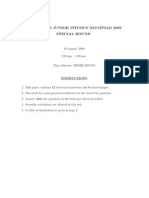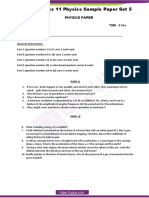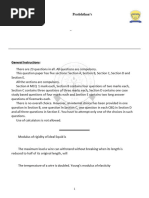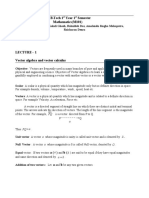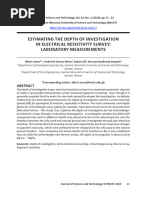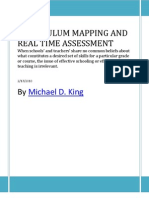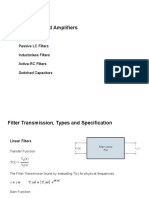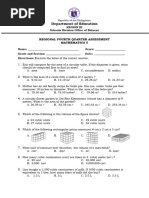Tutorial 10 - Q
Tutorial 10 - Q
Uploaded by
adamsyakir55Copyright:
Available Formats
Tutorial 10 - Q
Tutorial 10 - Q
Uploaded by
adamsyakir55Original Title
Copyright
Available Formats
Share this document
Did you find this document useful?
Is this content inappropriate?
Copyright:
Available Formats
Tutorial 10 - Q
Tutorial 10 - Q
Uploaded by
adamsyakir55Copyright:
Available Formats
PHY 094
SERWAY VUILLE,COLLEGE PHYSICS,11TH EDITION
2023/2024
Tutorial 10
Chapter 9.5 & 9.10
Multiple Choice Questions (MCQ)
1. Which of the following statements is TRUE regarding Archimedes’ principle?
A. Any object completely or partially surfaced in a fluid is buoyed up by force with a
magnitude equal to the weight of the fluid displaced by the object.
B. Any object completely or partially submerged in a fluid is buoyed up by force with a
magnitude equal to the weight of the fluid displaced by the object.
C. Any object completely or partially submerged in a fluid is buoyed up by momentum
with a magnitude equal to the weight of the fluid displaced by the object.
D. Any object completely or partially submerged in a fluid is buoyed down by momentum
with a magnitude equal to the weight of the fluid displaced by the object.
2. Stress is defined as:
A. Force per unit mass causing a deformation.
B. Force per unit time causing a deformation.
C. Force per unit area causing a deformation.
D. Force per unit length causing a deformation.
3. Which of the following statement is FALSE regarding strain?
A. Measurement of the amount of the deformation.
B. Stress is proportional to strain.
C. Strain is a dimensionless quantity.
D. Strain occurs when external momentum is applied to an object.
4. The density of lead is greater than iron and both metals are denser than water. If the
solid lead and solid iron are taken through the same dimensions,
A. the buoyant force on a solid lead object greater than the buoyant force acting on a
solid iron object of the same dimensions.
B. the buoyant force on a solid lead object equal to the buoyant force acting on a solid
iron object of the same dimensions.
C. the buoyant force on a solid lead object less than the buoyant force acting on a solid
iron object of the same dimensions.
D. the buoyant force on a solid lead object equal to the buoyant force acting on a solid
iron object of different dimensions.
5. State whether the following statements are ‘TRUE’ or ‘FALSE’.
i. The tensile stress is defined as the ratio of the magnitude of the external force F to
the cross-sectional area A.
ii. The tensile strain is defined as the ratio Δx/h, where Δx is the horizontal distance the
sheared face moves and h is the height of the object.
PHY094 Sem I 2023/2024
PHY 094
SERWAY VUILLE,COLLEGE PHYSICS,11TH EDITION
2023/2024
iii. The shear stress is defined as the ratio of the magnitude of the perpendicular force to
the area A of the face being sheared.
iv. The shear strain is the ratio of the change in length ΔL to the original length L0.
v. The volume stress is defined as the ratio of the change in the magnitude of the
applied force ΔF to the surface area A.
vi. The volume strain is equal to the change in volume ΔV divided by the original volume
V.
6. What does point M, N and O represent on the graph stress versus strain?
A. M: Elastic limit, N: Breaking point and O: Elastic behavior
B. M: Elastic behavior, N: Breaking point and O: Elastic limit
C. M: Elastic behavior, N: Elastic limit and O: Breaking point
D. M: Elastic limit, N: Elastic behavior and O: Breaking point
Structured Questions
Chapter 9.5 & 9.10
1. A table-tennis ball has a diameter of 3.80 cm and average density of 0.0840 g/cm3. What
force is required to hold it completely submerged under water?
Answer: ‒0.258 N
2. A 20.0-kg lead mass rests on the bottom of a pool.
(a) What is the volume of the lead?
Answer: 1.77 10‒3 m3
(b) What buoyant force acts on the lead?
Answer: 17.3 N
(c) Find the leads weight.
Answer: 196 N
(d) What is the normal force acting on the lead?
Answer: 179 N
PHY094 Sem I 2023/2024
PHY 094
SERWAY VUILLE,COLLEGE PHYSICS,11TH EDITION
2023/2024
3. A 62.0 kg survivor of a cruise line disaster rests atop a block of Styrofoam insulation,
using it as a raft. The Styrofoam has dimensions 2.00 m x 2.00 m x 0.0900 m. The
bottom 0.024 m of the raft is submerged.
(a) Draw a force diagram of the system consisting of the survivor and the raft.
(b) Write Newton’s second law for the system in one dimension, using B for buoyancy,
for the weight of the survivor, and r for the weight of the raft. (Set a=0)
Answer:
(c) Calculate the numeric value for the buoyancy, B. (Seawater has density 1025
kg/m3.)
Answer: 964 N
(d) Using the value of B and the weight of the survivor; calculate the weight wr of the
Styrofoam.
Answer: 356 N
(e) What is the density of the Styrofoam?
Answer: 101 kg/m3
(f) What is the maximum buoyant force corresponding to the raft being submerged up to
its top surface?
Answer: 3.62 103 N
(g) What total mass of survivors can the raft support?
Answer: 333 kg
4. A large balloon of mass 226 kg is filled with helium gas until its volume is 325 m3.
Assume the density of air is 1.29 kg/m3 and the density of helium is 0.179 kg/m3.
(a) Draw a force diagram for the balloon.
(b) Calculate the buoyant force acting on the balloon.
Answer: 4.11 103 N
(c) Find the net force on the balloon and determine whether the balloon will rise or fall
after it is released.
Answer: +1.33 103 N, the ballon rises
(d) What maximum additional mass can the balloon support in equilibrium?
Answer: 136 kg
(e) What happens to the balloon if the mass of the load is less than the value calculated
in part (d)?
(f) What limits the height to which the balloon can rise?
PHY094 Sem I 2023/2024
PHY 094
SERWAY VUILLE,COLLEGE PHYSICS,11TH EDITION
2023/2024
5. A light spring of force constant k=160 N/m rests vertically on the bottom of a large beaker
of water (Figure P9.28a). A 5.00 kg block of wood (density 650 kg/m3) is connected to
the spring, and the block-spring system is allowed to come to static equilibrium (Figure
P9.28b). What is the elongation L of the spring?
Answer: 0.165 m
Figure P9.28
6. A 200-kg load is hung on a wire of length 4.00 m, cross sectional area 0.200 x10 ‒4 m2
and Young modulus 8.00 x 10 10 N/m2.What is its increase in length?
Answer: 4.9 10‒3 m
7. A 90-kg rock climber attaches a 50-m long,1.0-cm diameter nylon rope to the top of one
of the Isle of Portland’s famous limestones cliffs. When fully supporting his weight, the
rope elongates 1.6 m. Find its Young’s modulus.
Answer: 3.5 108 Pa
8. A high-speed lifting mechanism supports an 800 kg object with a steel cable that is
25.0 m long and 4.0 cm2 in cross-sectional area.
(a) Determine the elongation of the cable.
Answer: 2.5 10‒3 m
(b) By what additional amount does the cable increase in length if the object is
accelerated upward at 3.0 m/s2?
Answer: 7 10‒4 m
(c) What is the greatest mass that can be accelerated upward at 3.0 m/s2 if the stress in
the cable is not to exceed the elastic limit of the cable, which is 2.2 x 108 Pa?
Answer: 6.9 103 kg
9. Determine the elongation of the rod in Figure P9.75 if it is under a tension of 5.8x10 3N.
Figure P9.75
Answer: 1.9 10‒2 m
PHY094 Sem I 2023/2024
PHY 094
SERWAY VUILLE,COLLEGE PHYSICS,11TH EDITION
2023/2024
10. Table 2 shows the values for Elastic Moduli of copper. (PAST YEAR PHY094 2019)
Table 2
Elastic Modulus Value (Pa)
Young's Modulus 11.0 1010
Shear Modulus 4.20 1010
Bulk Modulus 14.0 1010
i. A copper rod of length 2.00 m has a cross-sectional area of 6.00 10‒3 m2. The rod
is pulled by a 300 kg load. Determine the elongation of the rod.
Answer: 8.91 10‒6 m
ii. Calculate the pressure required to reduce the volume of the copper block by 10%.
Answer: 1.4 1010 Pa
PHY094 Sem I 2023/2024
You might also like
- Jntua Mechanical R13 SyllabusDocument130 pagesJntua Mechanical R13 Syllabusammuvarsh100% (1)
- Suketu Mishra - Class Xi Set A QPDocument3 pagesSuketu Mishra - Class Xi Set A QPSuketuNo ratings yet
- mechanical properties of solids2Document7 pagesmechanical properties of solids2mchandraswarajNo ratings yet
- Practice Test For Midterm 3 Chapters 13, 15, 16, 17, 18 in Preparation For The Midterm ExamDocument11 pagesPractice Test For Midterm 3 Chapters 13, 15, 16, 17, 18 in Preparation For The Midterm ExamRAIZZNo ratings yet
- PHY440 - Assignment 4 - Sept 2016 - Jan 2017Document3 pagesPHY440 - Assignment 4 - Sept 2016 - Jan 2017Ainaa NadhirahNo ratings yet
- Sample Paper 01 (2019-20)Document28 pagesSample Paper 01 (2019-20)Gaurav VasithaNo ratings yet
- BPhO Round 1 2017-2018 S2 PDFDocument12 pagesBPhO Round 1 2017-2018 S2 PDFWWTNo ratings yet
- CBSE Class 11 Physics Chapter 9 - Mechanical Properties of Solids Important Questions 2022-23Document49 pagesCBSE Class 11 Physics Chapter 9 - Mechanical Properties of Solids Important Questions 2022-23Fennix AGNo ratings yet
- Dodl Past Exam Questions - 240417 - 095612Document22 pagesDodl Past Exam Questions - 240417 - 095612omtyson72100% (1)
- SJPO Special Round 2009 Sample PDFDocument8 pagesSJPO Special Round 2009 Sample PDFziwei_from_chinaNo ratings yet
- Review Exam 3-NewDocument18 pagesReview Exam 3-NewhtyhongNo ratings yet
- Practice Hookes and SHM SolutionsDocument10 pagesPractice Hookes and SHM SolutionsZhong Huang100% (2)
- Physics Work Sheet 2Document6 pagesPhysics Work Sheet 2Debela mendaraNo ratings yet
- Ce2a 105 f08Document5 pagesCe2a 105 f08jessieNo ratings yet
- Free Test SOMDocument6 pagesFree Test SOMAbhishek MahtoNo ratings yet
- Class XI Physics SP SET 1Document4 pagesClass XI Physics SP SET 1Dhivya.k Dhivya.kNo ratings yet
- Namugongo A' Level Physics Seminar 2023Document18 pagesNamugongo A' Level Physics Seminar 2023abelcbucks06No ratings yet
- lab 3Document18 pageslab 3elfr.simplina.auNo ratings yet
- Physics MCQDocument6 pagesPhysics MCQMarc Liam Lu100% (1)
- Ce2a 105 f08Document5 pagesCe2a 105 f08Mona Mohamed SafwatNo ratings yet
- DELSU PHYSICS JUPEB MOCK EXAM 2024Document10 pagesDELSU PHYSICS JUPEB MOCK EXAM 2024Khasan TemitayoNo ratings yet
- Worksheet IIDocument2 pagesWorksheet IIgiziew belayNo ratings yet
- Tutorial 11 StudentsDocument3 pagesTutorial 11 StudentsIzzah SuhaiziNo ratings yet
- Physics 2 22013 - 2014 Competency Exam StudentsDocument1 pagePhysics 2 22013 - 2014 Competency Exam StudentsAron BalinesNo ratings yet
- Structural QuestionnaireDocument26 pagesStructural QuestionnairecarilloseanjoshuaNo ratings yet
- Question Bank For Term End Exam PhysicsDocument2 pagesQuestion Bank For Term End Exam PhysicsMedhavi PathadeNo ratings yet
- A Level Seminar ReadyDocument16 pagesA Level Seminar ReadyOnesmus GumisirizaNo ratings yet
- 1st Yr Hy 09Document4 pages1st Yr Hy 09Grezzju CauchiNo ratings yet
- Appendix E Questions 2013 Introduction To Naval Architecture Fifth EditionDocument8 pagesAppendix E Questions 2013 Introduction To Naval Architecture Fifth EditionCharles Jones0% (1)
- 11th physicsDocument4 pages11th physicsshubhamsharmawwNo ratings yet
- XI PHY PT2 2023-24Document3 pagesXI PHY PT2 2023-24sheejamolvs55No ratings yet
- Investigatory Project File by Ramneek Singh RCFDocument13 pagesInvestigatory Project File by Ramneek Singh RCFkuljeetkaur08652No ratings yet
- 2021 Physics - MCQ & EssayDocument15 pages2021 Physics - MCQ & Essaynkwochaephraim100% (1)
- Prehalf 11Document4 pagesPrehalf 11SVVV MANAGEMENT CLPNo ratings yet
- CBSE Class 11 Physics Sample Paper With Answers 2018Document3 pagesCBSE Class 11 Physics Sample Paper With Answers 2018RikuNo ratings yet
- Model Question Solution Made By: Krishna Shah Group 'A': Answer ExplanationDocument22 pagesModel Question Solution Made By: Krishna Shah Group 'A': Answer ExplanationKrishna ShahNo ratings yet
- Grade 11 - Physics Practice Paper 1Document8 pagesGrade 11 - Physics Practice Paper 1Rakshith VijayanandNo ratings yet
- Mechanical Properties of Matter IITJEEDocument14 pagesMechanical Properties of Matter IITJEESiddharth AcharyaNo ratings yet
- Xii Centre Phy Iit DPT-23 25.07.24Document4 pagesXii Centre Phy Iit DPT-23 25.07.24Deena chemistNo ratings yet
- CH 12Document8 pagesCH 12Qassem MohaidatNo ratings yet
- A+ Blog-Std-9-Physics-Annual Model Examination-2021-EmDocument3 pagesA+ Blog-Std-9-Physics-Annual Model Examination-2021-EmadhilasajeerNo ratings yet
- Moderated - TIU-UME-T217 - Autumn 2024Document3 pagesModerated - TIU-UME-T217 - Autumn 2024Rohit kumar SarkarNo ratings yet
- Seatwork 1 Mathematics: Specific WeightDocument5 pagesSeatwork 1 Mathematics: Specific WeightRenz PagcaliwaganNo ratings yet
- CBSE Class 9 Physics Worksheet - RevisionDocument4 pagesCBSE Class 9 Physics Worksheet - RevisionArnav BamoriaNo ratings yet
- Sos Secondary SchoolDocument6 pagesSos Secondary Schoolsanjayashrestha777No ratings yet
- MCQ in Strength of Materials Part 1 ECE Board ExamDocument11 pagesMCQ in Strength of Materials Part 1 ECE Board Examlance galorportNo ratings yet
- 2020 1 T6 ElasticityOscillationDocument2 pages2020 1 T6 ElasticityOscillationabdullah farhanNo ratings yet
- F4 Phy Pre-Necta I (2023)Document6 pagesF4 Phy Pre-Necta I (2023)Abdallah Kunamba100% (1)
- Physics Assignment (2014-15) Chapter: Gravitation - (Term 2) Class: IXDocument1 pagePhysics Assignment (2014-15) Chapter: Gravitation - (Term 2) Class: IXgurdeepsarora8738No ratings yet
- CBSE Class 11 Physics Sample Paper Set 5Document3 pagesCBSE Class 11 Physics Sample Paper Set 5Prajin MuruganNo ratings yet
- PhysicsDocument6 pagesPhysicsSudipto MondalNo ratings yet
- Physics 1 - Exam N Answers - MsomiBora - Com-5Document14 pagesPhysics 1 - Exam N Answers - MsomiBora - Com-5justnianlaurentNo ratings yet
- Enthuse-state Board_ Unitwise Set i -Physics Ques. Paper_x-18!11!2024Document2 pagesEnthuse-state Board_ Unitwise Set i -Physics Ques. Paper_x-18!11!2024aryan.guptaNo ratings yet
- 11 Phy PT2 2024Document3 pages11 Phy PT2 2024pandaybhushan1234No ratings yet
- A. Poisson's Ratio: Strength of MaterialsDocument31 pagesA. Poisson's Ratio: Strength of MaterialsAmpolNo ratings yet
- 5 Set Model Question - Physics (110) - Sci XI - UGHSSDocument15 pages5 Set Model Question - Physics (110) - Sci XI - UGHSSSachin ChakradharNo ratings yet
- Basic PhysicsDocument68 pagesBasic PhysicsMakeshwaranNo ratings yet
- Physics 2019Document11 pagesPhysics 2019itaeo1122100% (1)
- Nata Physics Material - Sachin PrajapatDocument101 pagesNata Physics Material - Sachin PrajapatFatema AfraNo ratings yet
- 4 3 Density and Pressure VW Il22A YuePvIDocument23 pages4 3 Density and Pressure VW Il22A YuePvIalexriderarcadeNo ratings yet
- Btech 1st Sem: Maths: Vector Algebra and Vector CalculusDocument7 pagesBtech 1st Sem: Maths: Vector Algebra and Vector CalculusTechno India GroupNo ratings yet
- Ajol-File-Journals 229 Articles 266564 660fd6d467eddDocument12 pagesAjol-File-Journals 229 Articles 266564 660fd6d467edd樱满恋No ratings yet
- I PUC Question BankDocument45 pagesI PUC Question BankNavneeth sunilNo ratings yet
- Lesson 3 Differential Leveling WorksheetDocument2 pagesLesson 3 Differential Leveling Worksheetcandy ghost benNo ratings yet
- Multiplication TeacherDocument60 pagesMultiplication Teacherapi-277778788100% (1)
- Statistics For Managers Using Microsoft Excel: 6 EditionDocument14 pagesStatistics For Managers Using Microsoft Excel: 6 EditionM BNo ratings yet
- Term Paper On Elastohydrodynamic LubricationDocument10 pagesTerm Paper On Elastohydrodynamic Lubricationwilliam ubongNo ratings yet
- Demaine E., Et Al. - The Open Problems Project (2009)Document90 pagesDemaine E., Et Al. - The Open Problems Project (2009)energumeno2No ratings yet
- UnaryDocument4 pagesUnaryjosh richardsNo ratings yet
- Mathematics - Assignment - 1: A B C DDocument2 pagesMathematics - Assignment - 1: A B C DAmogh PalyamNo ratings yet
- Chapter - 1 - Image Enhancement (Spatial & Freq. Domain)Document21 pagesChapter - 1 - Image Enhancement (Spatial & Freq. Domain)P. VENKATESHWARINo ratings yet
- Machine Elements Module 3Document108 pagesMachine Elements Module 3Arzel FarinasNo ratings yet
- Garg h Ed Pythagorean Fuzzy Sets Theory and ApplicationsDocument443 pagesGarg h Ed Pythagorean Fuzzy Sets Theory and ApplicationsrahmonjonwarriorNo ratings yet
- Al-Jawad, M. S., Et Al., 2016, Geological Model of Khasib Reservoir-Central Area-East Baghdad FieldDocument10 pagesAl-Jawad, M. S., Et Al., 2016, Geological Model of Khasib Reservoir-Central Area-East Baghdad Fieldwei zhouNo ratings yet
- Curriculum Mapping and Real Time AssessmentDocument20 pagesCurriculum Mapping and Real Time AssessmentMichael KingNo ratings yet
- Plastic Analysis of Beams and FramesDocument2 pagesPlastic Analysis of Beams and FramesFerialAssmaniNo ratings yet
- Filters and Tuned Amplifiers: Passive LC Filters Inductorless Filters Active-RC Filters Switched CapacitorsDocument31 pagesFilters and Tuned Amplifiers: Passive LC Filters Inductorless Filters Active-RC Filters Switched Capacitorspardeep184No ratings yet
- Problem Set 3Document2 pagesProblem Set 3Mailyn ElacreNo ratings yet
- Digital Signal ProcessingDocument2 pagesDigital Signal Processingmahil1234No ratings yet
- Math 5Document8 pagesMath 5Emmanuel RamirezNo ratings yet
- Mathematics: Factors Influencing Mathematics Achievement of University Students of Social SciencesDocument24 pagesMathematics: Factors Influencing Mathematics Achievement of University Students of Social SciencesBab SitaNo ratings yet
- Lab Report R3 Batch ReactorDocument9 pagesLab Report R3 Batch Reactorzy_yf0% (1)
- Reinforcement BBSDocument18 pagesReinforcement BBSAmro HarasisNo ratings yet
- Paper 1 Trial Papers 2022 Per Topic Eng-1Document58 pagesPaper 1 Trial Papers 2022 Per Topic Eng-1zwoandaamandasigNo ratings yet
- Lesson 2 Rational FunctionsDocument26 pagesLesson 2 Rational Functionsoluanah13No ratings yet
- Maths MCQ All ChaptersDocument25 pagesMaths MCQ All ChaptersSajani BhoviNo ratings yet
- 24maths Mock 1Document15 pages24maths Mock 1tomoketch1998No ratings yet









